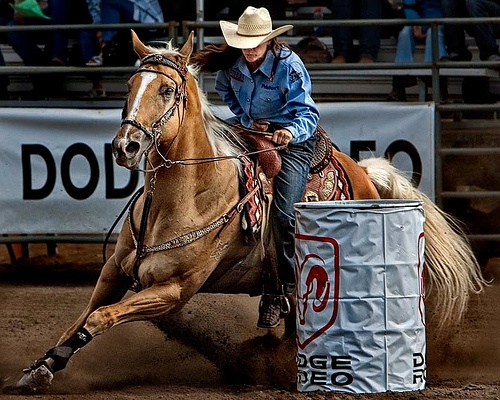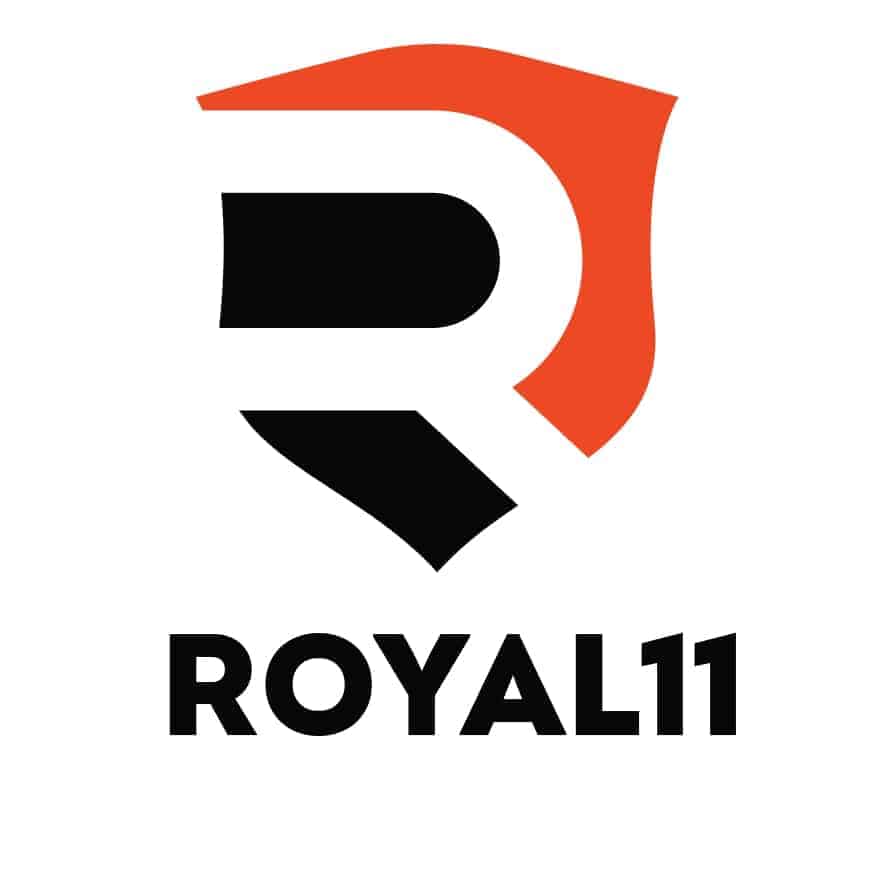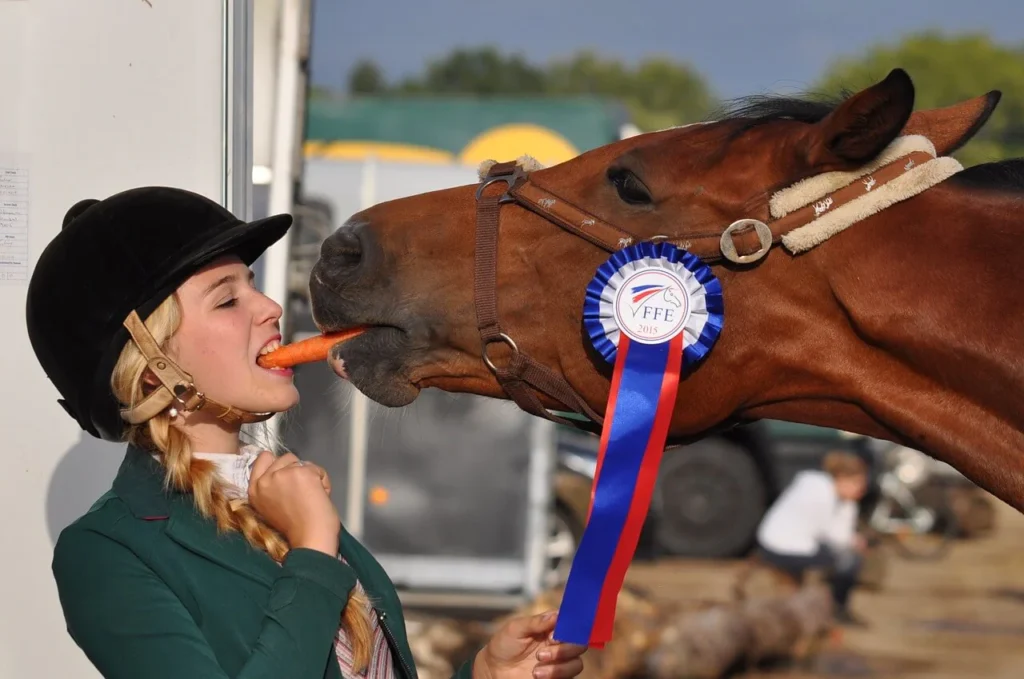Best Barrel Racing Times: What Is a Good Barrel Racing Time?

Table of Contents Show
- Introduction
- 2. Understanding Best Barrel Racing Times
- 3. What Constitutes a Best Barrel Racing Time?
- 4. Factors Influencing the Best Barrel Racing Times
- 5. Setting Personal Goals in Barrel Racing
- 6. Improving best Barrel Racing Times
- 7. Choosing the Right Barrel Racing Time Goal
- 8. Celebrating Achievements
- 9. Common Challenges in best Barrel Bacing Times
- 10. Conclusion
Introduction
Barrel racing is an exhilarating equestrian sport that combines speed, precision, and the undeniable bond between a rider and their horse. In this section, we’ll delve into the heart of barrel racing, exploring its basics and the critical role that best barrel racing times play in this dynamic competition.
1.1 Overview of Barrel Racing
Barrel racing is a timed rodeo event where horses and riders navigate a cloverleaf pattern around three barrels strategically placed in a triangular formation. The goal is to complete the course as quickly as possible without knocking over any barrels. It’s a thrilling spectacle that showcases the agility of the horse and the skill of the rider in executing tight turns and swift maneuvers.
As one of the most popular events in rodeo and equine sports, barrel racing attracts participants from various skill levels and backgrounds. The adrenaline rush, coupled with the precision required, makes it a favorite among both competitors and spectators.
1.2 Importance of Best Barrel Racing Times
The clock is a formidable opponent in barrel racing, and every fraction of a second counts. The time recorded for completing the barrel pattern is not just a number; it’s a reflection of the teamwork, training, and strategy invested by the rider and their horse. Understanding the significance of the best barrel racing times is key to appreciating the nuances of the sport.
2. Understanding Best Barrel Racing Times
2.1 Basics of Barrel Racing
At its core, barrel racing involves a horse and rider maneuvering a cloverleaf pattern around three barrels set in a triangular formation. The challenge lies in executing tight turns without toppling the barrels. The clock begins ticking as the duo bursts from the starting gate, creating a thrilling spectacle of speed and agility. Understanding the basic structure and rules of barrel racing is crucial for appreciating the complexities of achieving optimal racing times.
2.2 Factors Affecting the Best Barrel Racing Times
The quest for the perfect barrel racing time is influenced by a myriad of factors. From the horse’s breed and conformation to the rider’s skill and technique, every element plays a role in the seconds ticking away on the clock. Factors such as training, fitness, and the synergy between horse and rider become the invisible threads that weave into the fabric of competitive barrel racing. This section will delve into these variables, providing insights into the delicate balance required for success in the arena.
2.3 How Times are Measured in Barrel Racing
In the world of barrel racing, precision extends beyond the racetrack to the timing mechanism. But how exactly are times measured? From electronic timers to manual stopwatches, the methods employed in capturing those crucial seconds are as diverse as the riders themselves. This section will demystify the timing process, shedding light on the technology and methodologies that ensure accuracy in determining the best barrel racing times. Understanding this aspect adds a layer of appreciation for the meticulous nature of the sport and the pursuit of that perfect run against the clock. So, let’s untangle the intricacies and gain a deeper understanding of what it takes to not just race, but to race against time in the world of barrel racing.
3. What Constitutes a Best Barrel Racing Time?
3.1 Definition of a Good Time
A “good time” in barrel racing is not just a fleeting moment on the clock; it’s a nuanced blend of speed, precision, and flawless execution. It’s the sweet spot where the horse and rider seamlessly navigate the barrels, cutting through the course with optimal efficiency. Beyond the numerical value, a good time reflects the synchronization between horse and rider, showcasing the mastery of technique and the finesse of communication.
3.2 Benchmark Times in Barrel Racing
Every sport has its benchmarks, and barrel racing is no exception. Certain times stand as milestones, representing the epitome of skill and speed in the arena. Exploring these benchmark times provides aspiring riders with a standard to measure their progress and goals. Whether it’s the record-breaking runs that leave spectators in awe or the consistently strong performances that define a champion, this section will spotlight the times that have etched themselves into the history of barrel racing.
3.3 Variations Across Different Levels
Barrel racing is a sport that accommodates participants of various skill levels, from novice riders to seasoned professionals. Consequently, what constitutes a good time can vary across these levels of competition. Novice riders may celebrate different milestones compared to those competing at advanced levels. This section will explore the nuances of good times in barrel racing, considering the diverse landscape of skill and experience. Understanding these variations is essential for setting realistic goals and appreciating the journey of improvement, regardless of the level at which one participates.
4. Factors Influencing the Best Barrel Racing Times
Barrel racing is a dynamic collaboration between horse and rider, where success hinges on a delicate balance of various factors. In this section, we dissect the elements that significantly impact the best barrel racing times, both from the equine and human perspectives.
4.1 Horse-related Factors
4.1.1 Breed and Conformation
The horse’s breed and conformation lay the foundation for success in barrel racing. Different breeds possess unique traits that can influence their agility, speed, and turning ability. A horse with the right conformation—balanced proportions, strong hindquarters, and agile limbs—gains a competitive edge in navigating the tight turns around barrels. Understanding how these traits contribute to the horse’s performance is essential for riders aiming to optimize their racing times.
4.1.2 Training and Fitness
Behind every impressive barrel racing time is a horse that is not only physically fit but also mentally prepared. Training routines tailored to enhance agility, responsiveness, and endurance play a pivotal role. This includes exercises that refine the horse’s ability to execute precise turns and accelerate efficiently. Moreover, a well-conditioned horse is better equipped to handle the physical demands of the racecourse. This section explores the symbiotic relationship between a horse’s training regimen and its performance in the barrel racing arena.
4.2 Rider-related Factors
4.2.1 Skill and Technique
The rider’s skill and technique are the guiding hands that direct the horse through the intricate barrel pattern. From mastering the art of leaning into turns to efficiently using reins and body weight, the rider’s proficiency significantly influences the overall racing time. This section delves into the technical aspects of riding, offering insights into the techniques employed by skilled riders to shave off precious seconds without compromising precision.
4.2.2 Communication with the Horse
In barrel racing, communication between horse and rider is akin to a silent dialogue that unfolds at breakneck speed. The ability to convey subtle cues, anticipate the horse’s movements, and establish a seamless connection contributes to the fluidity of the run. Effective communication is born from trust and understanding, elements that define successful partnerships in barrel racing. This section explores the nuances of this equine-human connection, highlighting its impact on the overall performance and, consequently, the recorded racing times.
5. Setting Personal Goals in Barrel Racing
5.1 Importance of Personalized Goals
Personalized goals are the North Star of a barrel racer’s journey. They provide direction, motivation, and a tangible roadmap for improvement. Understanding the specific aspects of one’s performance that need enhancement is the first step toward setting effective goals. Whether it’s shaving off seconds from the racing time, refining a particular skill, or strengthening the bond between horse and rider, personalized goals make the pursuit of excellence a purposeful and rewarding endeavor. This section illuminates the significance of goals that resonate on a personal level, driving passion and commitment in the arena.
5.2 Tailoring Goals to Skill Level
One size does not fit all in the realm of barrel racing goals. Recognizing and respecting one’s current skill level is paramount when establishing realistic and achievable objectives. Novice riders may focus on mastering the basics of turns and transitions, while seasoned competitors might set their sights on refining advanced techniques. This section explores the art of tailoring goals to individual capabilities, ensuring that each rider’s journey is both challenging and attainable. By aligning goals with skill levels, riders create a staircase of achievement, with each step building the foundation for the next.
5.3 Long-Term and Short-Term Goal Setting
The journey in barrel racing is a marathon, not a sprint. Long-term goals provide a vision for the future, offering a sense of purpose and direction. Simultaneously, short-term goals serve as checkpoints along the way, allowing riders to celebrate incremental victories and stay motivated. Striking the right balance between these two dimensions is an art in and of itself. This section delves into the strategic approach of setting both long-term aspirations and short-term objectives, creating a roadmap that is both visionary and achievable.
6. Improving best Barrel Racing Times
In the quest for faster best barrel racing times, a combination of strategic training and skill development is key. This section dives into the nuances of optimizing performance, focusing on both equine and rider aspects, and the tactical analysis of the racing course.
6.1 Training Strategies for Horses
6.1.1 Conditioning for Speed and Endurance
Enhancing a horse’s speed and endurance is at the core of improvingbest barrel racing times. This involves a tailored conditioning program that includes interval training, sprints, and exercises specifically designed to build the necessary muscles for quick, agile turns. This section delves into the intricacies of horse training, offering insights into the regimen that maximizes physical capabilities and ensures peak performance on the racetrack.
6.1.2 Precision in Turns and Transitions
The ability to execute precise turns is a hallmark of a successful barrel racer. Training strategies that focus on refining a horse’s turning technique, balance, and responsiveness to cues play a pivotal role. This section explores the training methods that emphasize the nuances of turning, enabling horses to navigate the barrels with efficiency and accuracy.
6.2 Rider Training and Skill Development
6.2.1 Techniques for Optimal Rider Positioning
The rider’s position in the saddle directly influences the horse’s performance. Training for optimal rider positioning involves honing techniques such as weight distribution, body posture, and hand placement. This section provides insights into rider-specific training, focusing on the physical and technical aspects that contribute to a seamless partnership with the horse during a barrel run.
6.2.2 Enhancing Communication and Cue Responsiveness
Effective communication between rider and horse is the linchpin of successful barrel racing. Rider training should emphasize refining cues, establishing clear communication signals, and fostering a responsive partnership with the horse. This section delves into the nuances of rider training that go beyond physical prowess, emphasizing the importance of a harmonious connection with the equine partner.
6.3 Course Analysis and Strategy
6.3.1 Understanding Course Dynamics
Each barrel racing course presents a unique set of challenges. Analyzing the course dynamics involves studying the layout, surface conditions, and potential pitfalls. This section explores the strategic aspects of course analysis, offering riders insights into how a deep understanding of the course can be leveraged for improved performance.
6.3.2 Strategic Approaches for Different Courses
No two barrel racing courses are identical, and strategic adaptability is a valuable skill. This section delves into how riders can develop a repertoire of strategies tailored to different courses, taking into account factors such as track size, barrel placement, and surface variations. By combining technical skill with strategic intelligence, riders can navigate diverse courses with confidence and agility.
7. Choosing the Right Barrel Racing Time Goal
In the pursuit of excellence in barrel racing, setting the right time goal is a crucial step. This section delves into the considerations of balancing personal aspirations and the wisdom of seeking professional advice to chart a course that aligns ambition with realism.
7.1 Considering Personal Aspirations
7.1.1 Aligning Goals with Personal Values
Choosing the right barrel racing time goal begins with introspection. What are your personal aspirations in the sport? Whether it’s the thrill of competition, the joy of partnership with your horse, or the pursuit of excellence, understanding your values sets the foundation for goal-setting. This section explores the importance of aligning time goals with the deeper motivations that drive your involvement in barrel racing.
7.1.2 Recognizing Individual Progression
Every rider’s journey in barrel racing is unique. Considering personal aspirations involves recognizing and celebrating individual progression. Whether you’re a novice aiming to complete the course smoothly or an experienced rider chasing personal bests, this section emphasizes the significance of setting goals that resonate with your specific journey and contribute to your sense of accomplishment.
7.2 Balancing Ambition and Realism
7.2.1 Setting Incremental Targets
Ambition fuels progress, but realism tempers expectations. Striking the right balance involves setting incremental targets that challenge without being overwhelming. This section explores the art of breaking down larger-term goals into manageable steps, creating a staircase of achievement. By setting realistic milestones, riders can maintain motivation while steadily advancing toward their ultimate aspirations.
7.2.2 Acknowledging External Factors
In the unpredictable world of barrel racing, external factors such as track conditions, horse health, and unforeseen challenges can impact performance. Balancing ambition and realism requires acknowledging these variables and adjusting goals accordingly. This section delves into the importance of flexibility in goal setting, allowing riders to adapt to the dynamic nature of the sport while maintaining a steadfast commitment to improvement.
7.3 Seeking Professional Advice
7.3.1 Harnessing the Wisdom of Experienced Mentors
Professional advice can be a beacon of wisdom on the journey to setting the right barrel racing time goal. Seeking guidance from experienced mentors or coaches provides valuable insights into realistic benchmarks, effective training strategies, and the nuances of goal-setting. This section encourages riders to tap into the wealth of knowledge within the barrel racing community, fostering a culture of mentorship and continuous learning.
7.3.2 Utilizing Performance Analysis and Feedback
Professional advice extends beyond verbal guidance. Performance analysis and feedback, whether through video reviews or expert evaluations, offer tangible data to inform goal-setting. This section explores the benefits of utilizing performance metrics and expert feedback to refine time goals, ensuring they are rooted in a realistic understanding of current abilities and areas for improvement.
8. Celebrating Achievements
In the exhilarating world of barrel racing, celebrating achievements is not just a momentary joy; it’s a vital component of the rider’s journey. This section explores the significance of recognizing progress, the power of small milestones, and the role of a positive mindset in fostering a culture of accomplishment.
8.1 Recognizing Progress
8.1.1 The Journey as a Continuum
Celebrating achievements begins with recognizing progress as a continuous journey. Whether it’s shaving off a fraction of a second from your racing time or mastering a challenging technique, each step forward is a testament to dedication and effort. This section emphasizes the importance of acknowledging and appreciating incremental progress, cultivating a mindset that finds joy in the journey rather than just the destination.
8.1.2 Documenting Achievements
Documenting achievements, both big and small, serves as a tangible reminder of how far you’ve come. From personal bests to successful training sessions, this section explores the benefits of maintaining a record of accomplishments. Reflecting on these documented milestones not only instills a sense of pride but also fuels motivation for the challenges that lie ahead.
8.2 Importance of Small Milestones
8.2.1 The Building Blocks of Success
Small milestones are the building blocks of success in barrel racing. Whether it’s mastering a specific maneuver, achieving consistent turns, or conquering a challenging course element, these incremental victories contribute to the larger tapestry of improvement. This section delves into the significance of setting and celebrating small milestones, creating a sense of achievement that propels riders forward.
8.2.2 Motivation through Mini-Goals
Breaking down larger goals into manageable mini-goals provides riders with continuous motivation. This section explores the psychology of small victories, explaining how achieving these mini-goals not only boosts confidence but also maintains enthusiasm for the overall journey. By celebrating the small steps, riders stay engaged and inspired throughout their pursuit of excellence.
8.3 Building a Positive Mindset
8.3.1 The Influence of Mindset on Performance
A positive mindset is the engine that drives sustained success in barrel racing. This section delves into the profound impact of mindset on performance, emphasizing the role of optimism, resilience, and a growth-oriented attitude. Cultivating a positive mindset is not just about celebrating achievements but also embracing challenges as opportunities for learning and improvement.
8.3.2 Rituals for Positive Reinforcement
In the face of challenges, establishing rituals for positive reinforcement becomes a powerful tool. This section explores how simple acts, such as visualization, affirmations, or reflection on past successes, can contribute to building and maintaining a positive mindset. By incorporating these rituals into training and competition routines, riders create a mental environment conducive to achievement and resilience.
9. Common Challenges in best Barrel Bacing Times
Barrel racing, like any sport, presents its share of challenges. This section explores the common hurdles riders may encounter, offering insights into overcoming setbacks, dealing with unexpected variables, and staying motivated in the face of adversity.
9.1 Overcoming Setbacks
9.1.1 Embracing Setbacks as Learning Opportunities
Setbacks are not roadblocks but rather detours on the path to improvement. This section discusses the mindset shift required to view setbacks as valuable learning opportunities. By understanding the lessons embedded in challenges, riders can emerge stronger, more resilient, and better equipped for future successes.
9.1.2 Adjusting Goals in Response to Setbacks
When faced with setbacks, adjusting goals can be a strategic move. This section explores the adaptive nature of goal-setting, emphasizing the importance of flexibility. By recalibrating expectations and focusing on incremental progress, riders navigate setbacks with a sense of purpose and determination.
9.2 Dealing with Unexpected Variables
9.2.1 The Unpredictability of Barrel Racing
Barrel racing is inherently unpredictable, with variables ranging from weather conditions to the horse’s mood. This section explores the art of adapting to unexpected variables, emphasizing the role of preparation and mental resilience. By developing strategies to handle unforeseen circumstances, riders can maintain focus and composure during competitions.
9.2.2 Preparing for the Unforeseen
Preparation is a rider’s best ally against the unexpected. This section delves into proactive approaches to training and competition planning, ensuring riders are equipped to handle various variables. From course analysis to horse readiness, a comprehensive preparation strategy minimizes the impact of unforeseen factors on performance.
9.3: Staying Motivated in the Face of Challenges
9.3.1 Finding Inspiration in Challenges
Challenges are not roadblocks but rather invitations to tap into untapped potential. This section explores how facing challenges head-on can be a wellspring of inspiration. By reframing challenges as opportunities for growth, riders can fuel their motivation and commitment to continuous improvement.
9.3.2 Cultivating a Supportive Environment
A supportive environment plays a crucial role in staying motivated during challenging times. This section emphasizes the importance of a strong support system, including trainers, fellow riders, and friends. By fostering a community that understands the rigors of barrel racing, riders gain encouragement and motivation to persevere through difficulties.
10. Conclusion
As we conclude this exploration into the world of barrel racing, it becomes clear that the journey is as significant as the destination. From the thrill of achieving personal goals to navigating the challenges that pepper the racetrack, barrel racing is a dynamic blend of skill, partnership, and resilience. By celebrating achievements, setting realistic goals, and embracing challenges as stepping stones, riders not only enhance their performance but also deepen their connection with the essence of barrel racing—a pursuit that goes beyond racing against time to racing towards personal excellence. In the spirit of continuous improvement, may every rider find joy in the dance around the barrels and the journey of becoming the best team they can be.
Also Read: texas gun trader: A Deep Dive into Texan Firearm Culture






Responses